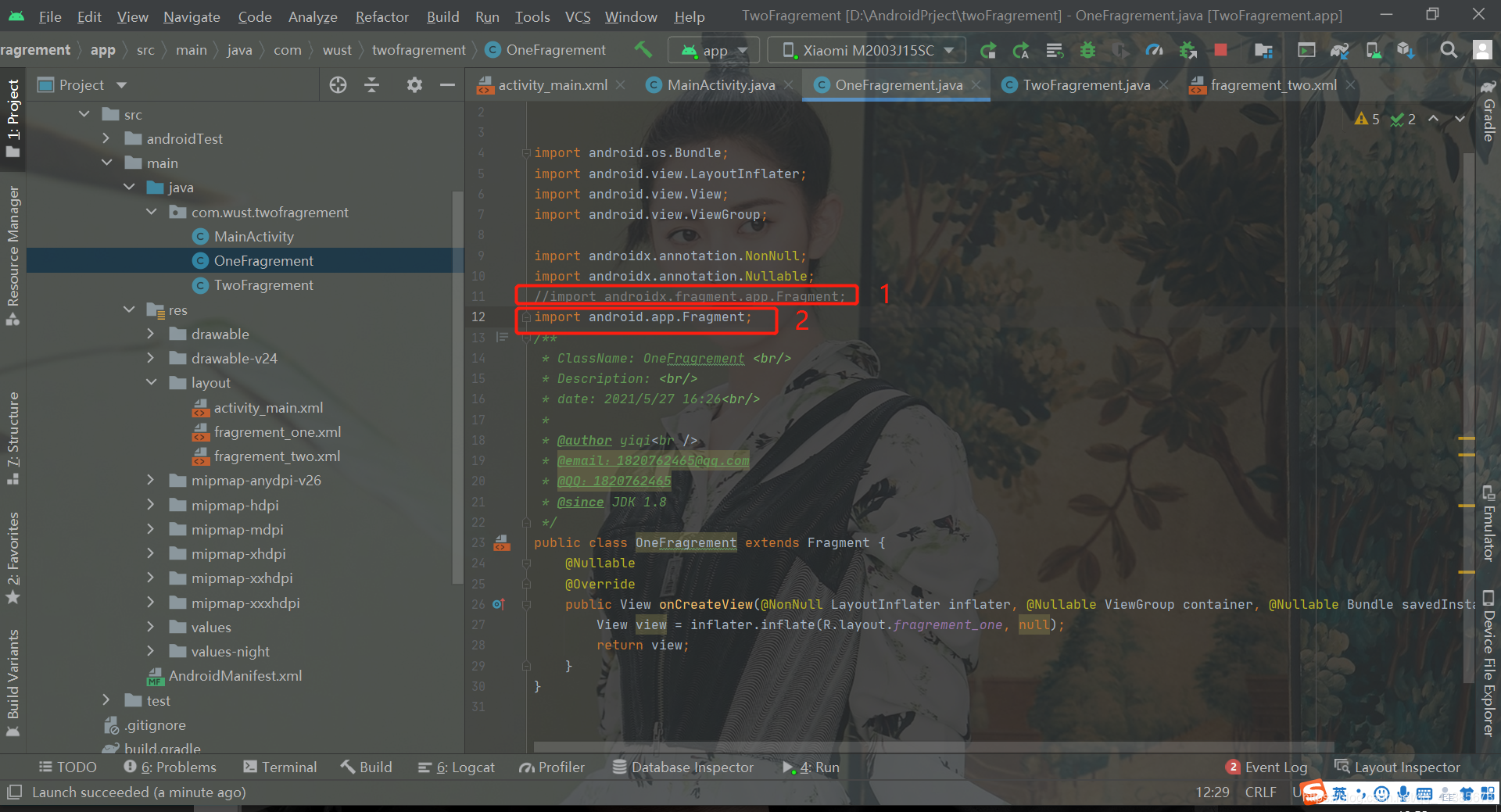Fragment 的使用,为什么有人说 Android 开发不再吃香
import androidx.annotation.NonNull;
import androidx.annotation.Nullable;
/**
ClassName: OneFragrement <br/>
Description: <br/>
date: 2021/5/27 16:26<br/>
@author yiqi<br />
@email:1820762465@qq.com
@QQ:1820762465
@since JDK 1.8
*/
public class OneFragrement extends Fragment {
@Nullable
@Override
public View onCreateView(@NonNull LayoutInflater inflater, @Nullable ViewGroup container, @Nullable Bundle savedInstanceState) {
View view = inflater.inflate(R.layout.fragrement_one, null);
return view;
}
}
package com.wust.twofragrement;
import android.app.Fragment;
import android.os.Bundle;
import android.view.LayoutInflater;
import android.view.View;
import android.view.ViewGroup;
import androidx.annotation.NonNull;
import androidx.annotation.Nullable;
/**
ClassName: OneFragrement <br/>
Description: <br/>
date: 2021/5/27 16:26<br/>
@author yiqi<br />
@email:1820762465@qq.com
@QQ:1820762465
@since JDK 1.8
*/
public class TwoFragrement extends Fragment {
@Nullable
@Override
public View onCreateView(@NonNull LayoutInflater inflater, @Nullable ViewGroup container, @Nullable Bundle savedInstanceState) {
View view = inflater.inflate(R.layout.fragrement_two, null);
return view;
}
}
注意:在这一步中你引入的 fragment 包要正确,一定要是 android.app.Fragment; 另外一个是?androidx.fragment.app.Fragment; 在这种静态调用方法里,两个包任选其一即可。

动态调用?
第一步,编写 xml 布局文件,使用?FrameLayout 占位
<?xml version="1.0" encoding="utf-8"?>
<LinearLayout
xmlns:android="http://schemas.android.com/apk/res/android"
xmlns:app="http://schemas.android.com/apk/res-auto"
xmlns:tools="http://schemas.android.com/tools"
android:layout_width="match_parent"
android:layout_height="match_parent"
android:orientation="vertical"
tools:context=".MainActivity">
<FrameLayout
android:id="@+id/fl_one"
android:layout_width="match_parent"
android:layout_height="300dp"/>
<FrameLayout
android:id="@+id/fl_two"
android:layout_width="match_parent"
android:layout_height="300dp"/>
</LinearLayout>
第二步,编写 fragment 类代码
package com.wust.twofragrement;
import android.app.Fragment;
import android.os.Bundle;
import android.view.LayoutInflater;
import android.view.View;
import android.view.ViewGroup;
import androidx.annotation.NonNull;
import androidx.annotation.Nullable;
/**
ClassName: OneFragrement <br/>
Description
: <br/>
date: 2021/5/27 16:26<br/>
@author yiqi<br />
@email:1820762465@qq.com
@QQ:1820762465
@since JDK 1.8
*/
public class OneFragrement extends Fragment {
@Nullable
@Override
public View onCreateView(@NonNull LayoutInflater inflater, @Nullable ViewGroup container, @Nullable Bundle savedInstanceState) {
View view = inflater.inflate(R.layout.fragrement_one, null);
return view;
}
}
package com.wust.twofragrement;
import android.app.Fragment;
import android.os.Bundle;
import android.view.LayoutInflater;
import android.view.View;
import android.view.ViewGroup;
import androidx.annotation.NonNull;
import androidx.annotation.Nullable;
/**
ClassName: OneFragrement <br/>
Description: <br/>
date: 2021/5/27 16:26<br/>
@author yiqi<br />
@email:1820762465@qq.com
@QQ:1820762465
@since JDK 1.8
*/
public class TwoFragrement extends Fragment {
@Nullable
@Override
public View onCreateView(@NonNull LayoutInflater inflater, @Nullable ViewGroup container, @Nullable Bundle savedInstanceState) {
View view = inflater.inflate(R.layout.fragrement_two, null);












评论